Calculation Method for Uplift Capacity of Suction Caisson in Sand Considering Different Drainage Conditions
Abstract
1. Introduction
2. Numerical Model and Its Verification
2.1. Finite Element Model
2.1.1. Mesh Element
2.1.2. Interface Properties and Boundary Conditions
2.1.3. Soil Constitutive Model
2.2. Model Verification
2.3. Simulation Parameters
3. Prediction of Differential Pressure Beneath Caisson Lid
3.1. Seepage Responses of Uplift Caisson
3.2. Differential Pressure Equation
3.2.1. Equation Deduction
3.2.2. Effect of Normalized Pullout Velocity
3.2.3. Effect of Aspect Ratio
3.2.4. Effect of
3.2.5. Verification of Differential Pressure Equation
4. Calculation Method of Uplift Capacity
4.1. The Uplift Capacity Mechanism of Suction Caisson
4.2. Fully Drained Capacity
4.2.1. Soil Stress State
4.2.2. Soil Stress Release Model
4.2.3. Verification of Soil Stress Release Model
4.3. Undrained Capacity
5. Conclusions
Author Contributions
Funding
Institutional Review Board Statement
Informed Consent Statement
Data Availability Statement
Conflicts of Interest
References
- Pérez-Collazo, C.; Greaves, D.; Iglesias, G. A review of combined wave and offshore wind energy. Renew. Sustain. Energy Rev. 2015, 42, 141–153. [Google Scholar] [CrossRef]
- Guo, Z.; Yu, L.Q.; Wang, L.Z.; Bhattacharya, S.; Nikitas, G.; Xing, Y. Model tests on the long-term dynamic performance of offshore wind turbines founded on monopiles in sand. J. Offshore Mech. Arct. Eng. 2015, 137, 041902. [Google Scholar] [CrossRef]
- Abhinav, K.A.; Saha, N. Stochastic response of jacket supported offshore wind turbines for varying soil parameters. Renew. Energy 2017, 101, 550–564. [Google Scholar] [CrossRef]
- Zhou, W.J.; Wang, L.Z.; Guo, Z.; Zhang, Y.R.; Rui, S.J. Numerical model for suction caisson under axial cyclic loadings. Ocean Eng. 2021, 240, 109956. [Google Scholar] [CrossRef]
- Wang, X.F.; Zeng, X.W.; Li, J.L. Vertical performance of suction bucket foundation for offshore wind turbines in sand. Ocean Eng. 2019, 180, 40–48. [Google Scholar] [CrossRef]
- Achmus, M.; Abdel-Rahman, K.; Schaefer, D.; Kuo, Y.S.; Chung, C.Y.; Tseng, Y.H. Capacity degradation method for driven steel piles under axial cyclic loadings. In Proceedings of the International Society of Offshore and Polar Engineers, San Francisco, CA, USA, 25–30 June 2017. [Google Scholar]
- Bhattacharya, S.; Nikitas, G.; Arany, L.; Nikitas, N. Soil-structure interactions (SSI) for offshore wind turbines. Eng. Technol. Ref. 2017, 24, 16. [Google Scholar]
- Guo, Z.; Wang, L.Z.; Yuan, F. Set-up and pullout mechanism of suction caisson in a soft clay seabed. Mar. Georesour. Geotechnol. 2014, 32, 135–154. [Google Scholar] [CrossRef]
- Iskander, M.; El-Gharbawy, S.; Olson, R. Performance of suction caissons in sand and clay. Can. Geotech. J. 2002, 39, 576–584. [Google Scholar] [CrossRef]
- Patel, S.K.; Singh, B. A parametric study on the vertical pullout capacity of suction caisson foundation in cohesive soil. Innov. Infrastruct. Solut. 2019, 4, 1. [Google Scholar] [CrossRef]
- Guo, Z.; Jeng, D.; Guo, W.; He, R. Simplified approximation for seepage effect on penetration resistance of suction caissons in sand. Ships Offshore Struct. 2017, 12, 980–990. [Google Scholar] [CrossRef]
- Mana, D.S.K.; Gourvenec, S.; Randolph, M.F. Numerical Modelling of Seepage beneath Skirted Foundations Subjected to Vertical Uplift. Comput. Geotech. 2014, 55, 150–157. [Google Scholar]
- Thieken, K.; Achmus, M.; Schroder, C. On the Behavior of Suction Buckets in Sand under Tensile Loads. Comput. Geotech. 2014, 60, 88–100. [Google Scholar] [CrossRef]
- Shen, K.; Zhang, Y.; Klinkvort, R.T.; Sturm, H.; Jostad, H.P.; Sivasithamparam, N.; Guo, Z. Numerical simulation of suction bucket under vertical tension loading. In Proceedings of the 8th International Conference on Offshore Site Investigation and Geotechnics, London, UK, 12–14 November 2017; Volume 1, pp. 488–497. [Google Scholar]
- Shen, K.; Zhang, Y.; Wang, K.; Wang, B.; Zhao, X. Effect of partial drainage on the pullout behaviour of a suction bucket foundation. Europ. J. Environ. Civil Eng. 2021, 26, 1–29. [Google Scholar]
- Wang, X.X.; Yang, Q.; Tang, X.W. Responses of suction buckets subjected to sustained vertical uplift. Mar. Georesources. Geotechnology 2020, 40, 36–51. [Google Scholar] [CrossRef]
- Moghaddam, F.; Imam, R. The seepage study of transient caisson pull-out in sand. Ocean Eng. 2022, 258, 111804. [Google Scholar]
- Vaitkunaite, E. Physical Modelling of Bucket Foundations Subjected to Axial Loading. Ph.D. Thesis, Aalborg University, Aalborg, Denmark, 2016. [Google Scholar]
- Hong, S.; Vicent, S.; Gu, K.Y.; Kim, S.R. Effect of drainage condition on the pullout characteristics of bucket foundations in sand. Ocean Eng. 2022, 260, 111994. [Google Scholar]
- Houlsby, G.T.; Byrne, B.W. Design procedures for installation of suction caissons in sand. Geotech. Eng. 2005, 158, 135–144. [Google Scholar] [CrossRef]
- Houlsby, G.T.; Kelly, R.B.; Byrne, B.W. The tensile capacity of suction caissons in sand under rapid loading. In Proceedings of the International Symposium on Frontiers in Offshore Geomechanics, Perth, Australia, 19–21 September 2005; pp. 405–410. [Google Scholar] [CrossRef]
- Senders, M. Suction Caissons in Sand as Tripod Foundations for Offshore Wind Turbines. Ph.D. Thesis, The University of Western Australia, Perth, Australia, 2008. [Google Scholar]
- Vicent, S.; Kim, S.R.; Bong, T. Effect of loading rate on the pullout capacity of offshore bucket foundations in sand. Ocean Eng. 2020, 210, 107427. [Google Scholar]
- Vicent, S.; Hong, S.; Bong, T.; Kim, S.R. Effects of embedment depth on the pull-out capacity of bucket foundations in sand. Ocean Eng. 2021, 237, 109643. [Google Scholar]
- DNV. Support Structures for Wind Turbines (DNVGL-ST-0126); Det Norske Veritas: Bærum, Norway, 2018. [Google Scholar]
- ISO 19901-4:2003; Specific Requirements for Offshore Structures, Part 4-Geotechnical and Foundation Design Considerations. International Organisation for Standardisation: Geneva, Switzerland, 2014.
- OWA. Suction Installed Caisson Foundations Design Guidelines for Offshore Wind. Offshore Wind Accelerator. 2019. Available online: https://www.engins.org/event/owa-suction-installed-caisson-foundations-design-guidelines-for-offshore-wind/ (accessed on 19 December 2022).
- Guo, Z.; Jeng, D.S.; Guo, W.; Wang, L.Z. Failure mode and capacity of suction caisson under inclined short-term static and one-way cyclic loadings. Mar. Georesour. Geotechnol. 2018, 36, 52–63. [Google Scholar] [CrossRef]
- Systemes, Dassault, Abaqus 2017 Documentation; Dassault Systèmes Simulia Corp: Providence, RI, USA, 2017.
- Cao, J.; Phillips, R.; Popescu, R. Numerical analysis of the behavior of Suction Caissons in clay. Int. J. Offshore Polar Eng. 2003, 13, 154–159. [Google Scholar]
- Dafalias, Y.F.; Manzari, M.T. Simple plasticity sand model accounting for fabric change effects. J. Eng. Mech. 2004, 130, 622–634. [Google Scholar] [CrossRef]
- Dafalias, Y.F.; Papadimitriou, A.G.; Li, X.S. Sand plasticity model accounting for inherent fabric anisotropy. J. Eng. Mech. 2004, 130, 1319–1333. [Google Scholar] [CrossRef]
- Dafalias, Y.F.; Taiebat, M. SANISAND-Z: Zero elastic range sand plasticity model. Geotechnique 2016, 66, 999–1013. [Google Scholar] [CrossRef]
- Tran, M.N. Installation of Suction Caissons in Dense Sand and the Influence of Silt and Cemented Layers. Ph.D. Thesis, The University of Sydney, Sydney, Australia, 2005. [Google Scholar]
- Byrne, B.W.; Houlsby, G.T. Experimental investigations of the response of suction caissons to transient vertical loading. J. Geotech. Geoenviron. Eng. 2002, 128, 926–939. [Google Scholar]
- Byrne, B.W.; Houlsby, G.T. Experimental investigations of the response of suction caissons to transient combined loading. J. Geotech. Geoenviron. Eng. 2004, 130, 240–253. [Google Scholar]
- Zhu, B.; Dai, J.L.; Kong, D.Q.; Feng, L.Y.; Chen, Y.M. Centrifuge modelling of uplift response of suction caisson groups in soft clay. Can. Geotech. J. 2020, 57, 1294–1303. [Google Scholar] [CrossRef]
- Blaker, Ø.; Andersen, K.H. Shear strength of dense to very dense Dogger Bank sand. In Frontiers in Offshore Geotechnics III, Proceedings of the 3rd International Symposium on Frontiers in Offshore Geotechnics, Oslo, Norway, 10–12 June 2015; Meyer, V., Ed.; CRC Press: London, UK, 2015; pp. 1167–1172. [Google Scholar]
- Blaker, Ø.; Andersen, K.H. Cyclic properties of dense to very dense silica sand. Soils Found. 2019, 59, 982–1000. [Google Scholar]
- Cotterill, C.; Dove, D.; Long, D.; James, L.; Duffy, C.; Mulley, S.; Forsberg, C.F.; Tjelta, T.I. Dogger Bank-A Geo Challenge. In Proceedings of the Seventh International Conference, London, UK, 12–14 September 2012. [Google Scholar]
- Forchheimer, P. Wasserbewegung durch boden. Z. Ver. Deutsch, Ing. 1901, 45, 1782–1788. [Google Scholar]
- Chai, Z.; Shi, B.; Lu, J.; Guo, Z. Non-Darcy flow in disordered porous media: A lattice Boltzmann study. Comput. Fluids 2010, 39, 2069–2077. [Google Scholar] [CrossRef]
- Sharqawy, M.H.; Lienhard, J.H.; Zubair, S.M. Thermophysical properties of seawater: A review of existing correlations and data. Desal. Water Treat. 2010, 16, 354–380. [Google Scholar]
- Grossmann, S.; Lohse, D. Scaling in thermal convection: A unifying theory. J. Fluid Mech. 2000, 407, 27–56. [Google Scholar] [CrossRef]
- Deng, W.; Carter, J.P. A theoretical study of the vertical uplift capacity of suction caissons. Int. J. Offshore Polar Eng. 2002, 12, 89–97. [Google Scholar]
- Han, F.; Ganju, E.; Salgado, R.; Prezzi, M. Effects of Interface Roughness, Particle Geometry, and Gradation on the Sand–Steel Interface Friction Angle. J. Geotech. Geoenvironmental Eng. 2018, 144, 04018096. [Google Scholar]
- Marek, K. Experimental investigation of skirted foundation in sand subjected to rapid uplift. Arch. Hydro-Eng. Environ. Mech. 2020, 67, 17–34. [Google Scholar]
- Sgardeli, C.G. A Finite Element Analysis of the Pullout Capacity of Suction Caissons in Clay. Ph.D. Thesis, Massachusetts Institute of Technology, Cambridge, MA, USA, 2009. [Google Scholar]
- Koh, K.X.; Wang, D.; Hossain, M.S. Numerical simulation of caisson installation and dissipation in kaolin clay and calcareous silt. Bull. Eng. Geol. Environ. 2017, 77, 953–962. [Google Scholar]
- Sun, L.; Qi, Y.; Feng, X.; Liu, Z. Tensile capacity of offshore bucket foundations in clay. Ocean Eng. 2020, 197, 106893. [Google Scholar]
- Idriss, I.M.; Boulanger, R.W. 2nd Ishihara lecture: SPT-and CPT-Based relationships for the residual shear strength of liquefied soils. Soil Dyn. Earthq. Eng. 2015, 68, 57–68. [Google Scholar]
- Guo, Z.; Jeng, D.S.; Zhao, H.Y.; Guo, W.; Wang, L.Z. Effect of seepage flow on sediment incipient motion around a free spanning pipeline. Coast. Eng. 2019, 143, 50–62. [Google Scholar]
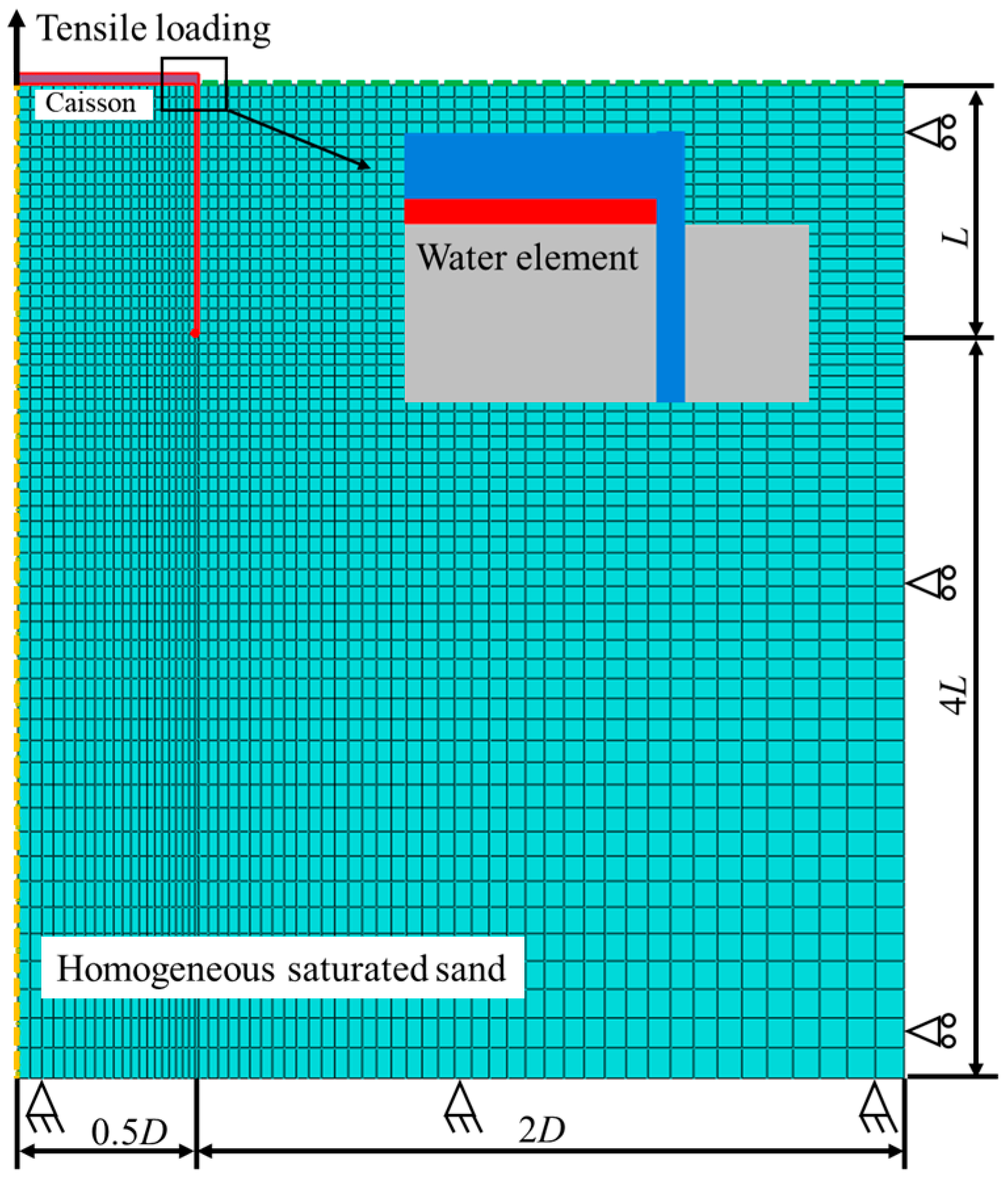



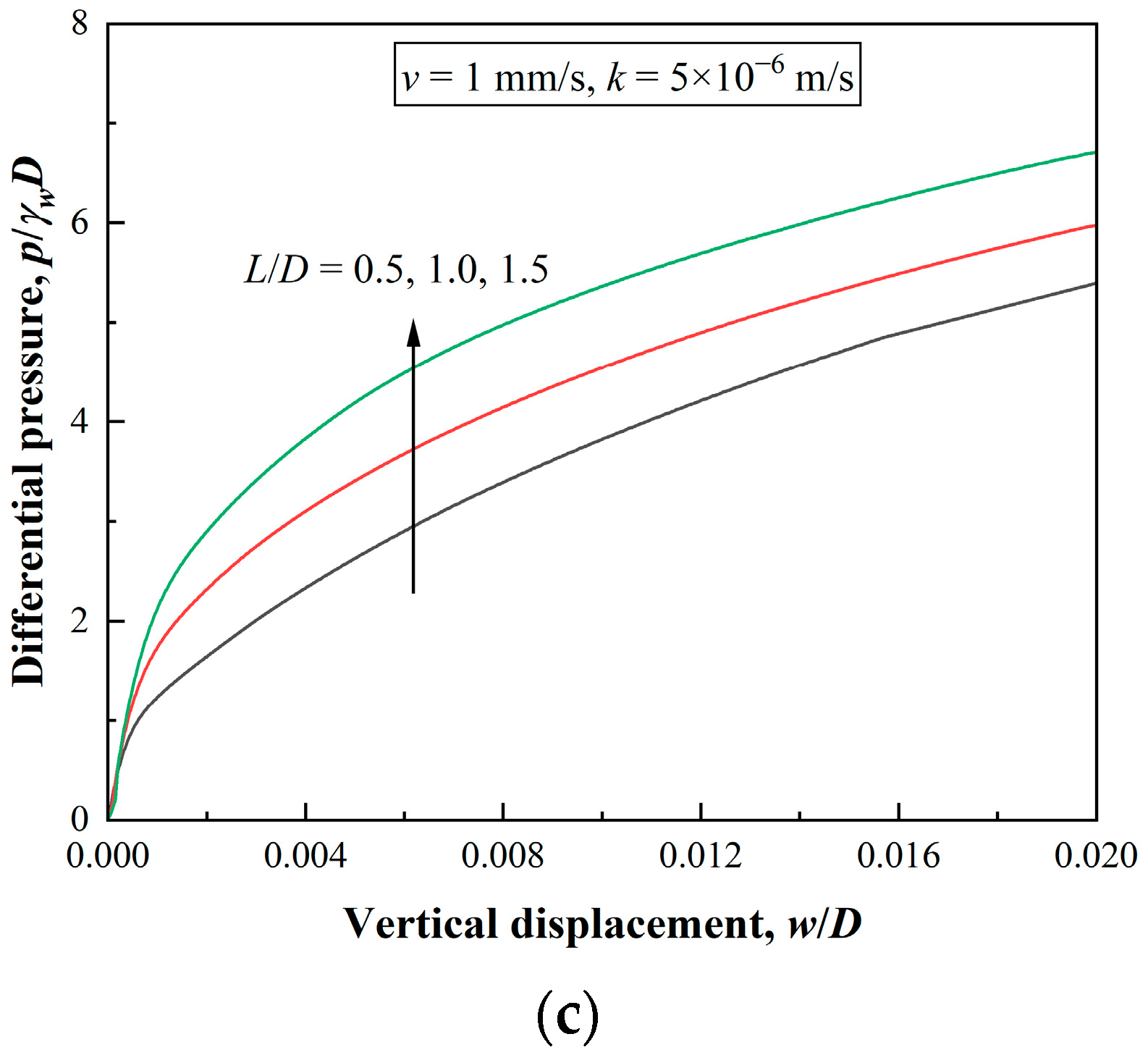


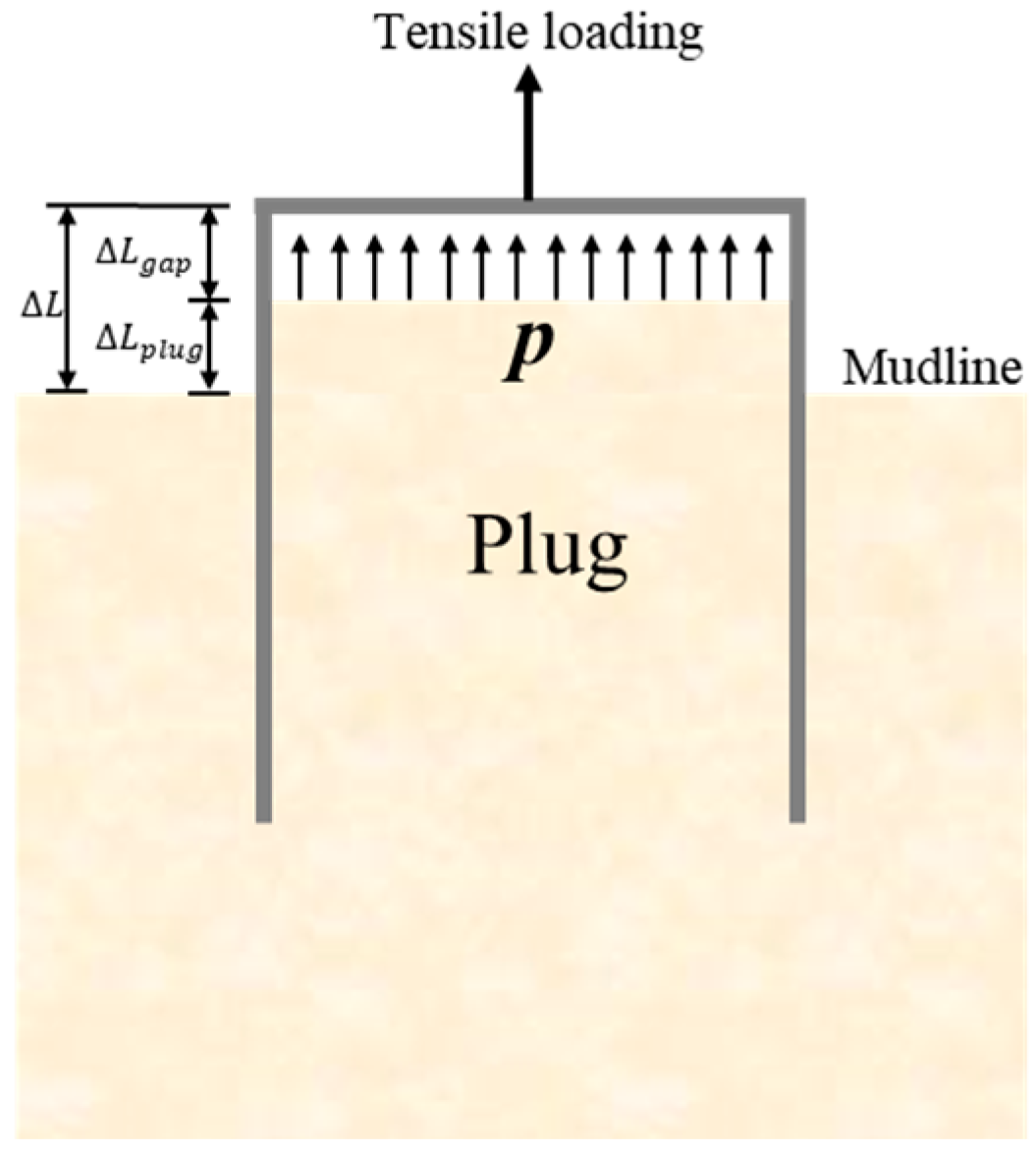
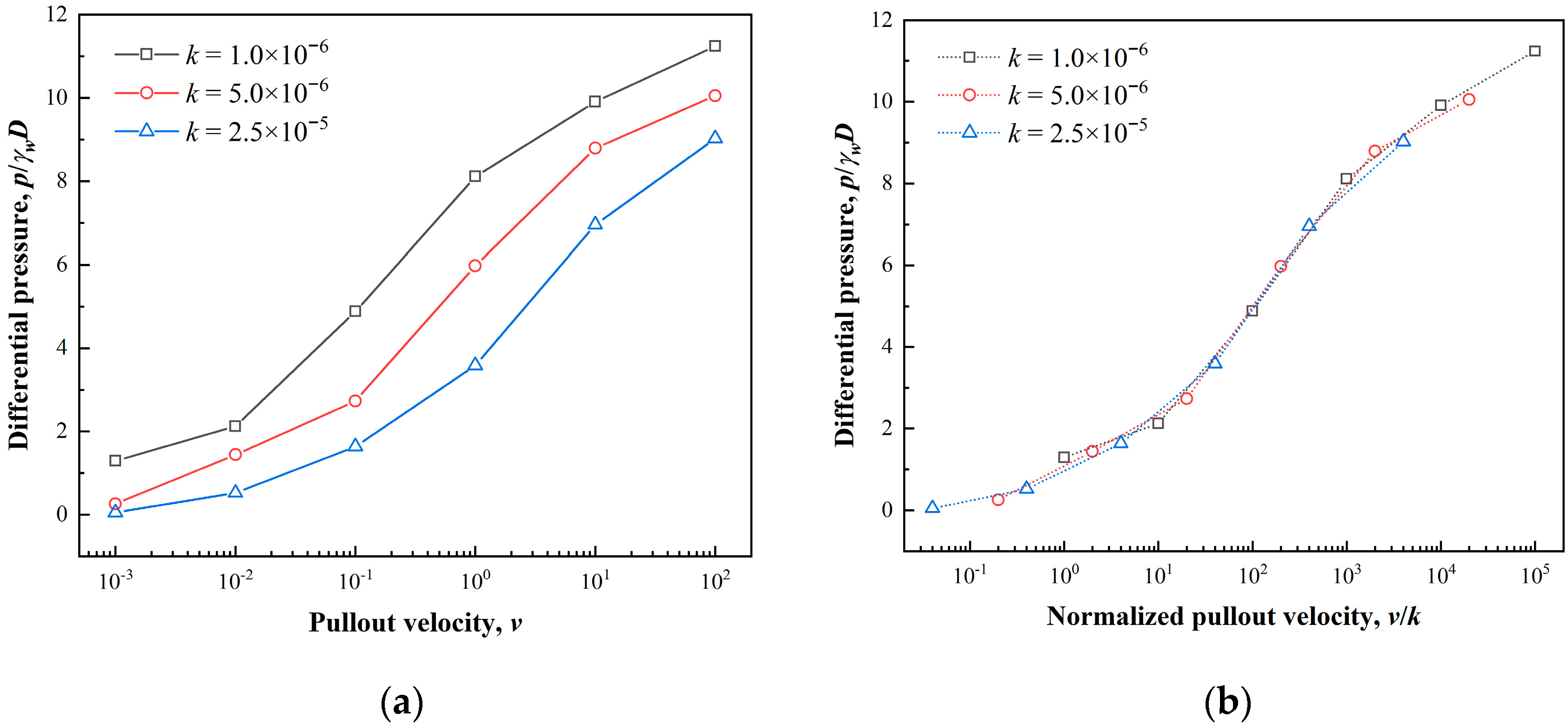
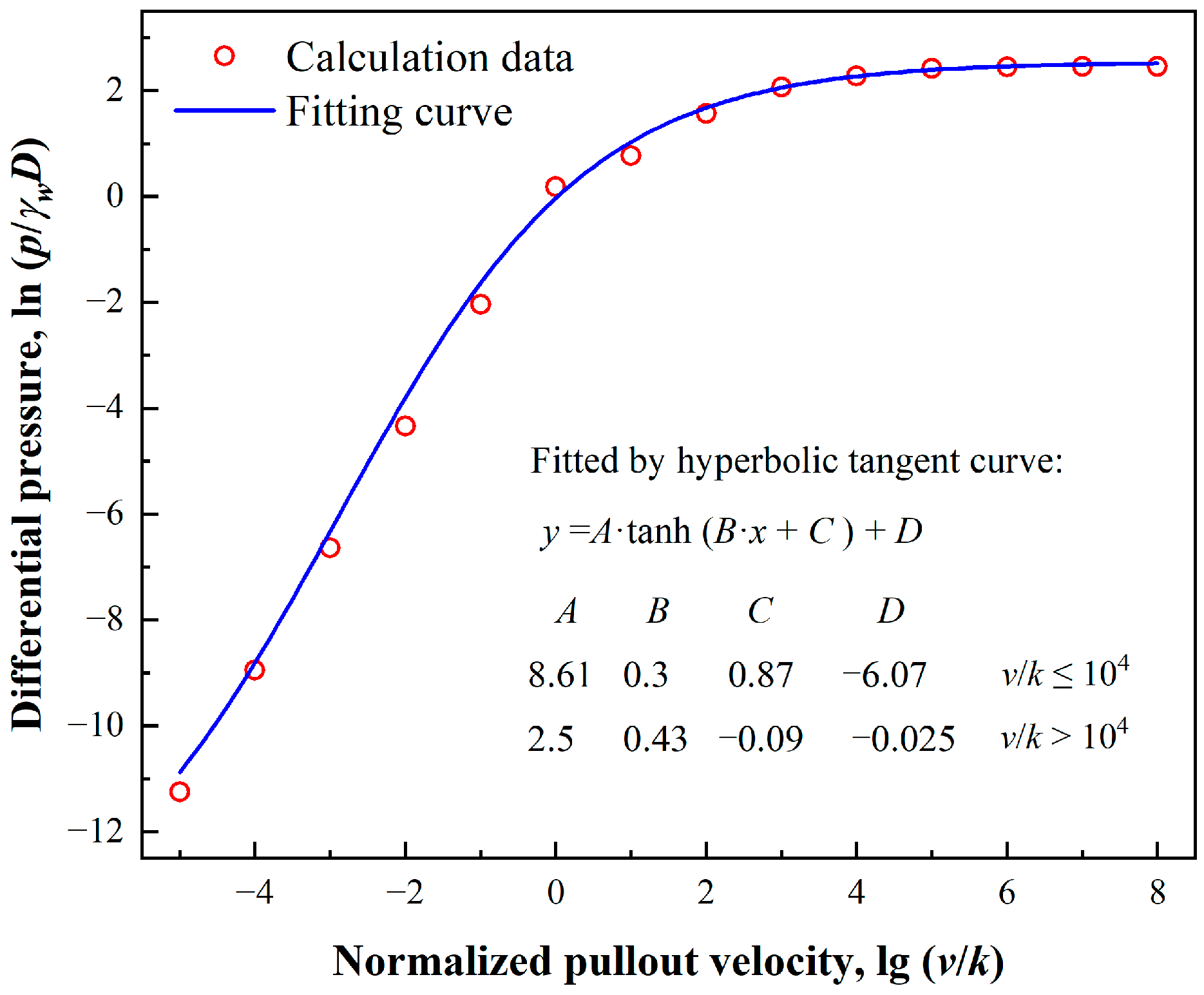
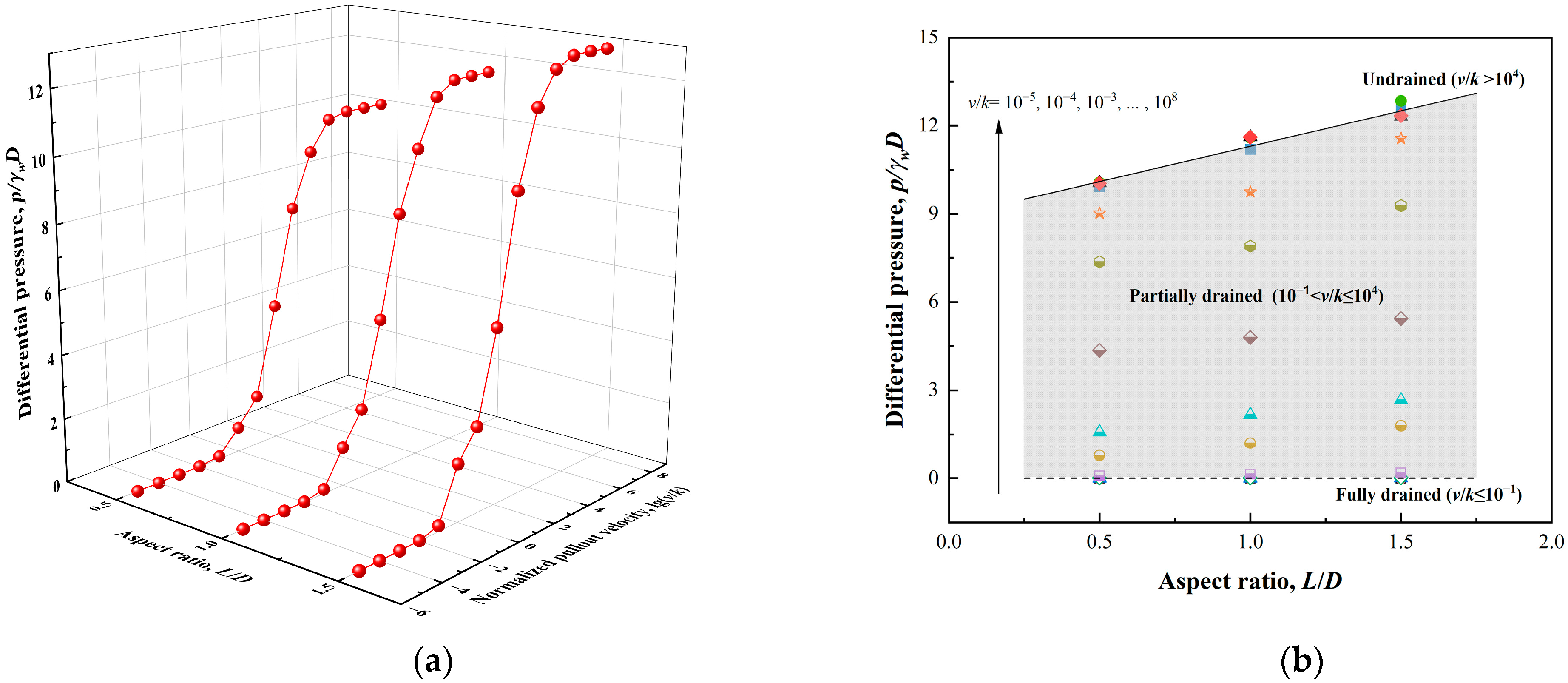

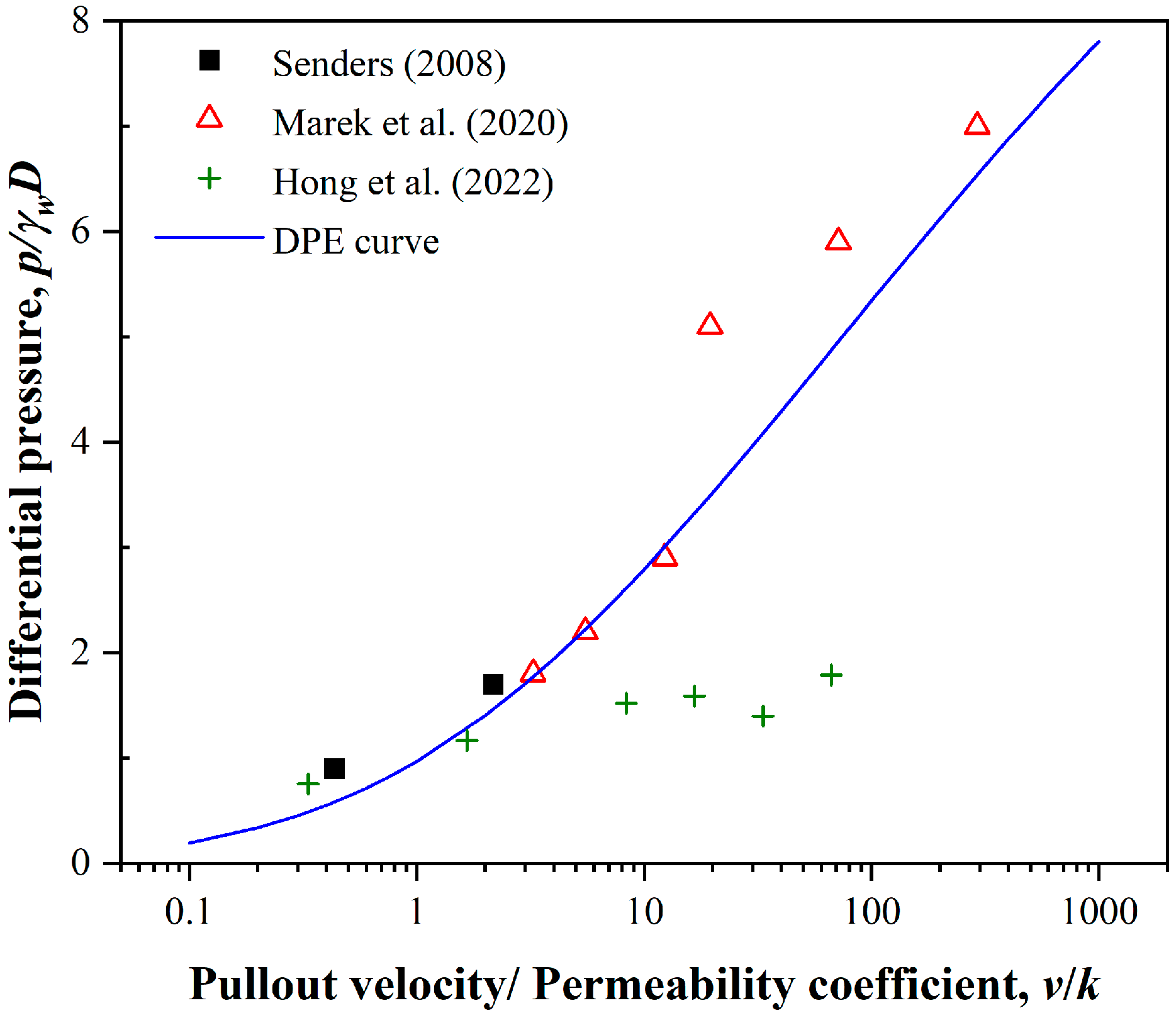

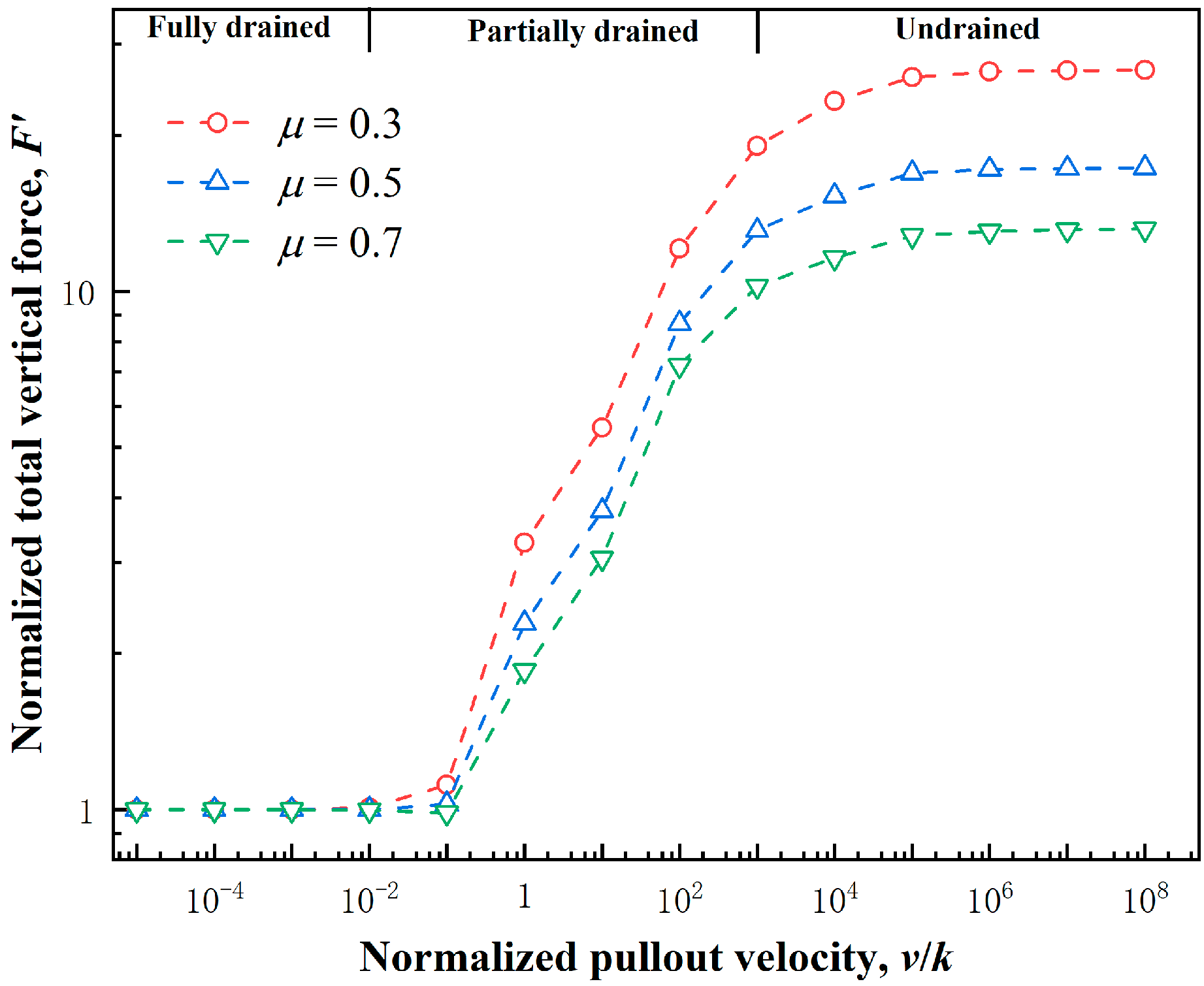
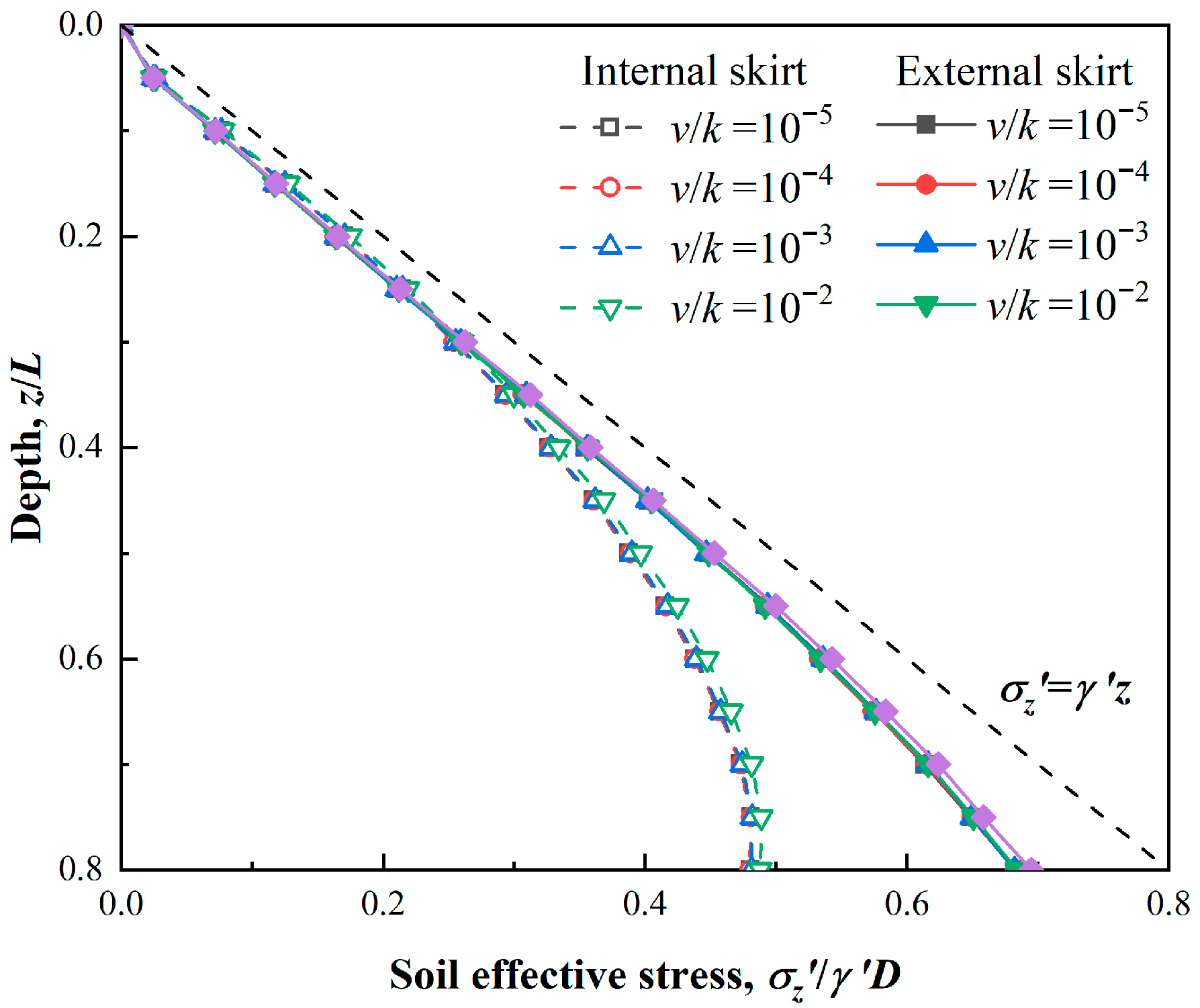
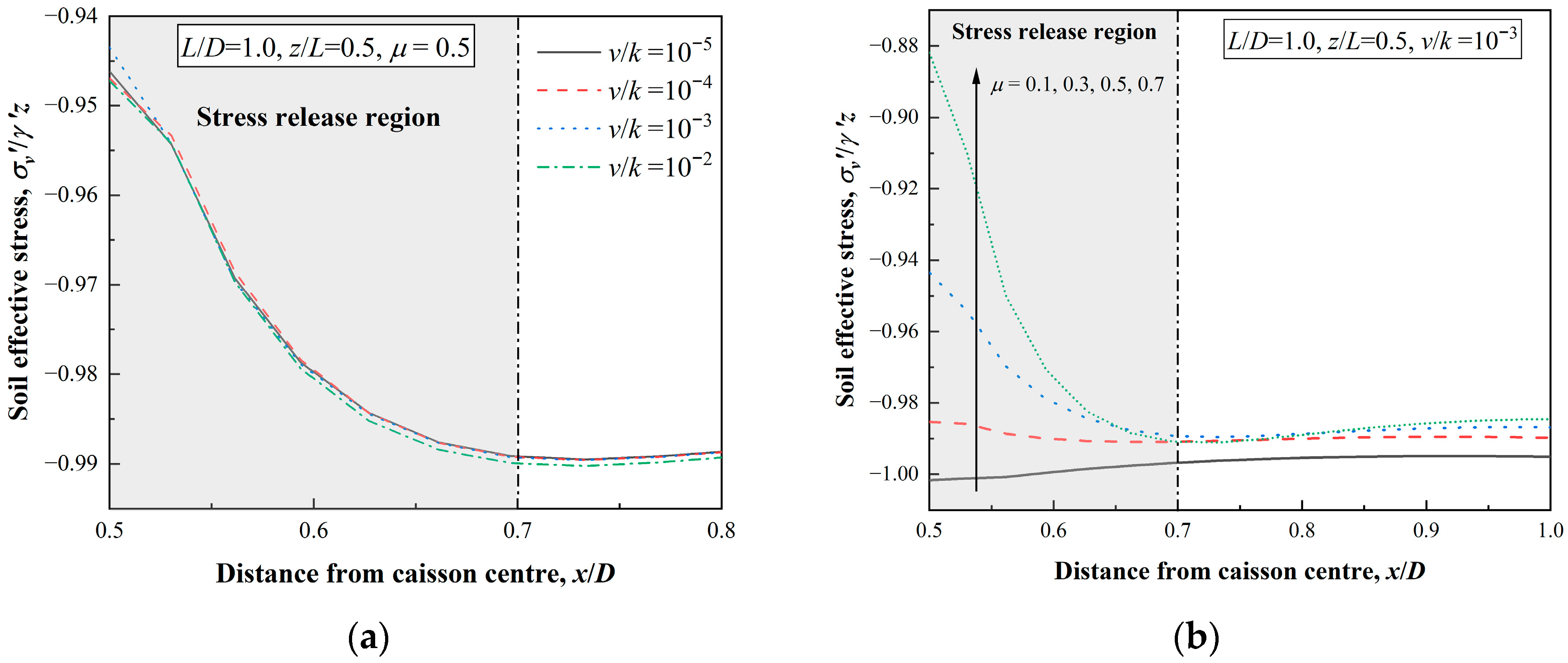
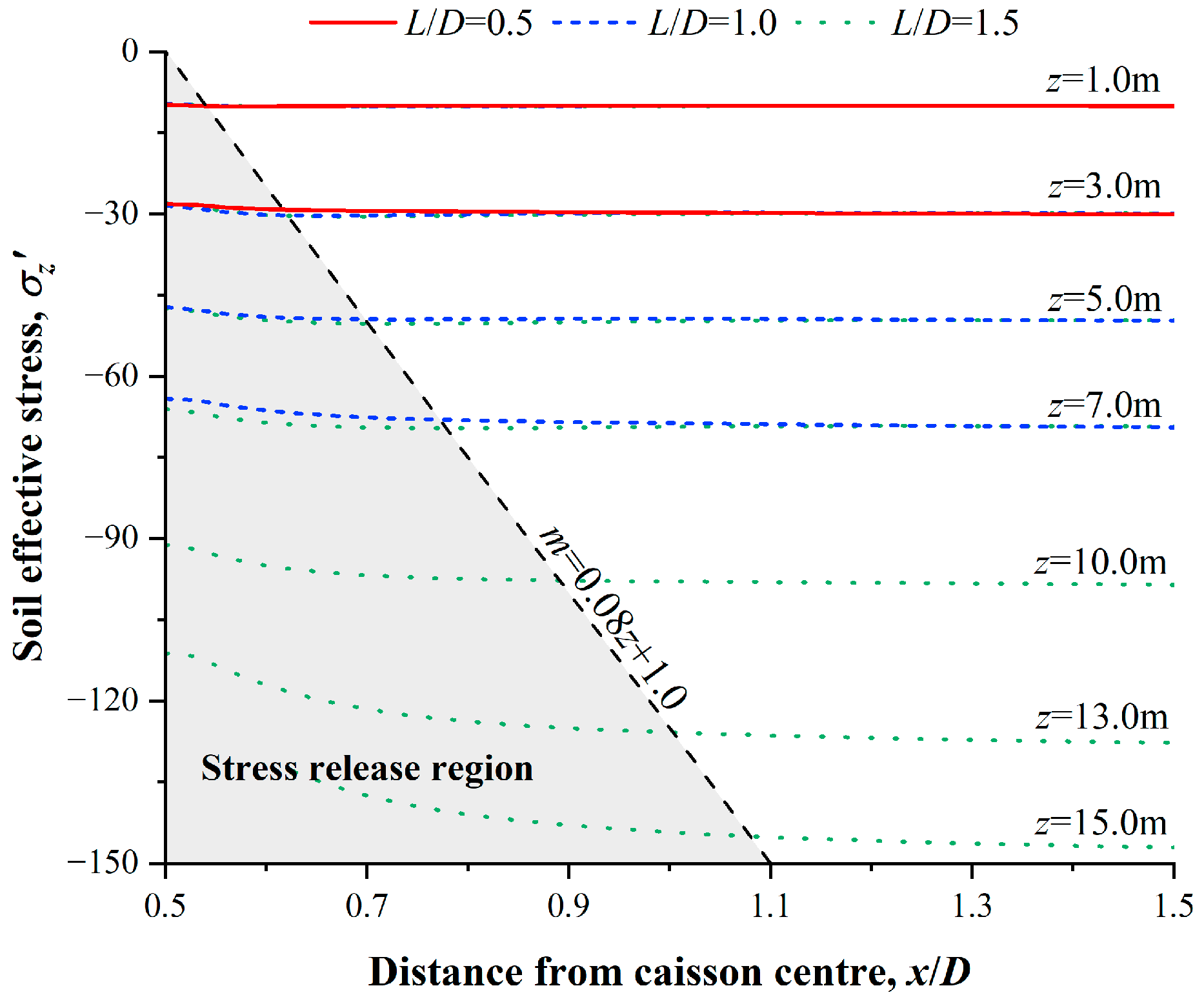
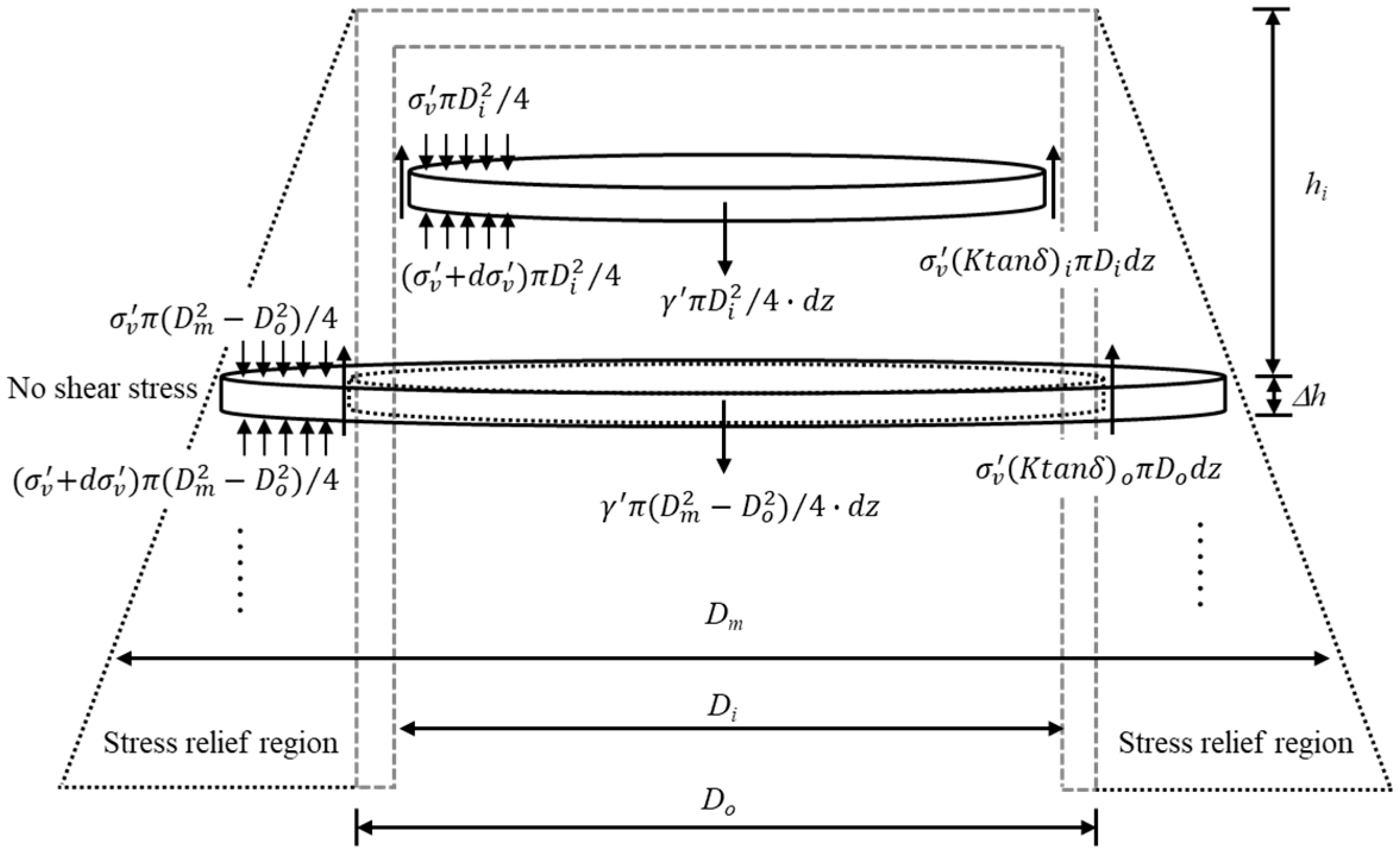
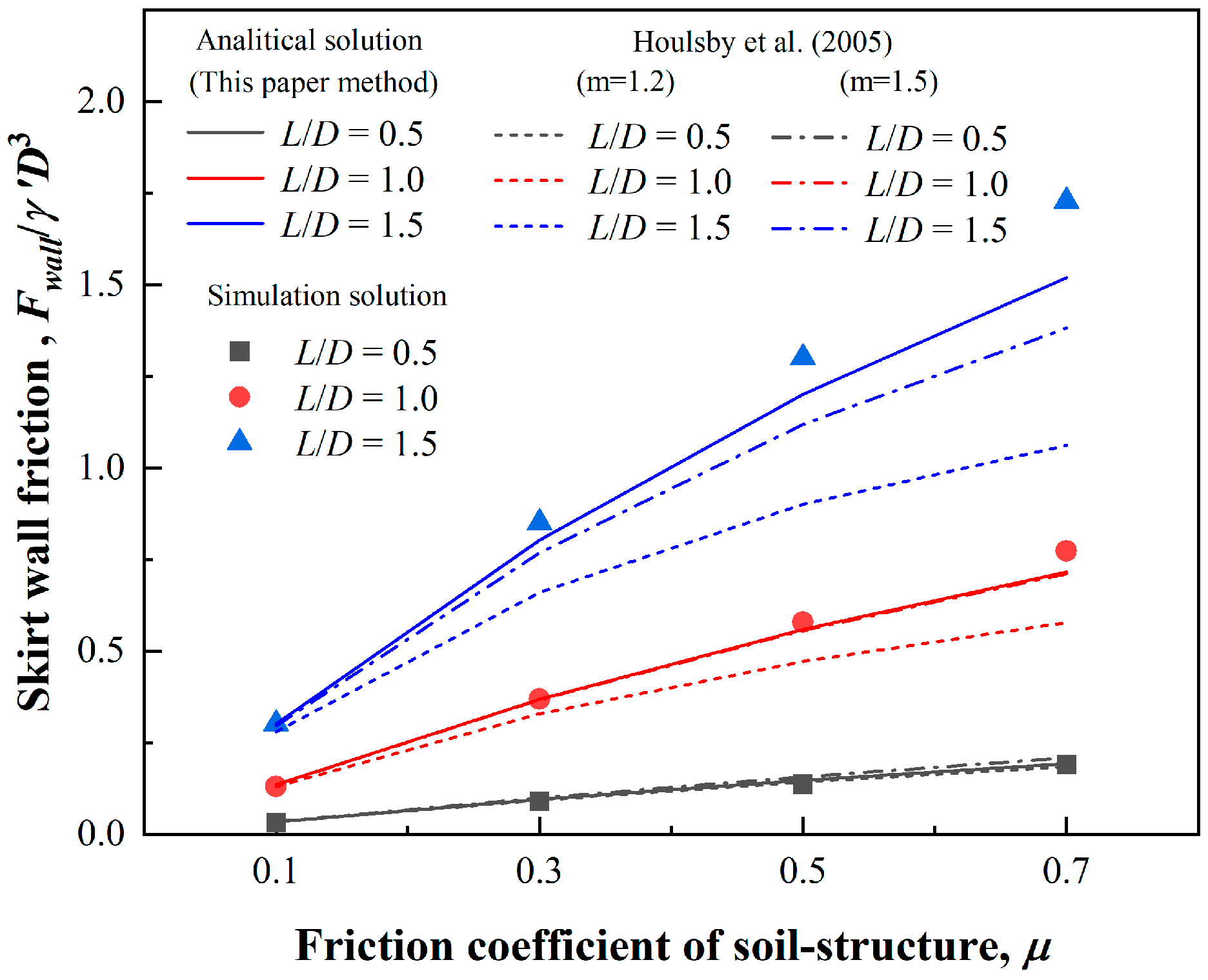
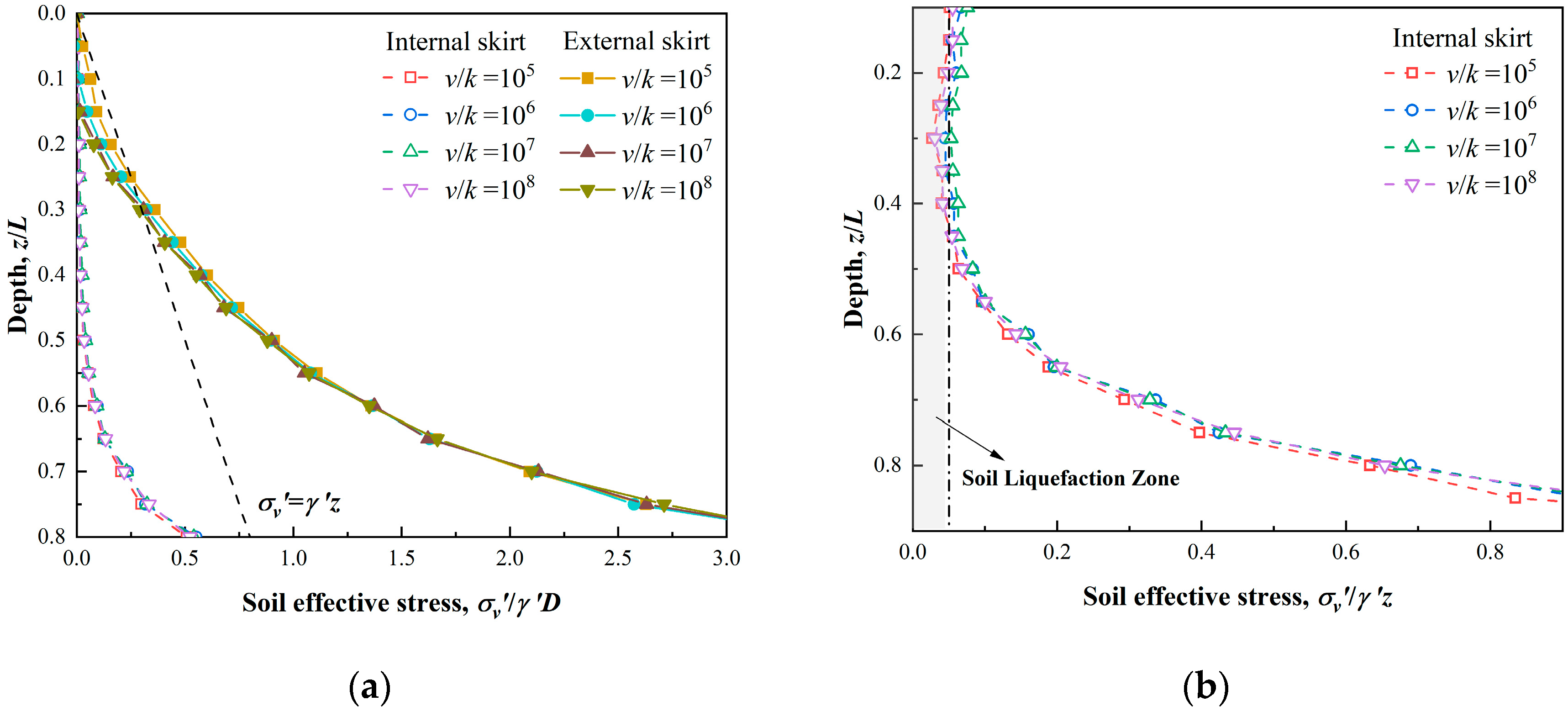
| Properties | Values |
|---|---|
| Caisson | |
| Diameter, D (m) | 10 |
| Skirt length, L (m) | 10 |
| Skirt wall thickness, ts (m) | 0.1 (ts/D = 0.01) |
| Friction coefficient of soil-structure, μ | 0.5 |
| Material property | Rigid body |
| Seabed soil | |
| Permeability coefficient, k0 (m/s) | 5 × 10−6 |
| Initial void ratio, es | 0.658 |
| Buoyant unit weight, γ′ (kN/m3) | 10 |
| Specific weight of water, γw (kN/m3) | 10 |
| Earth pressure coefficient, K | 0.45 |
| Water element | |
| Element thickness, tw (m) | 0.2 |
| Young’s modulus, Ew (kPa) | 10−5 |
| Poisson’s ratio, nw | 0 |
| Permeability coefficient, kw (m/s) | 1 |
| Initial void ratio, ew | 0.658 |
| Parameter | Variable | Value |
|---|---|---|
| Elasticity | G0 | 206 |
| ν′ | 0.05 | |
| Critical state | Mc | 1.4 |
| Me | 1.05 | |
| λc | 0.007 | |
| ec0 | 0.75 | |
| ee0 | 0.699 | |
| ξ | 0.7 | |
| Yield surface | m | 0.05 |
| Plastic modules | h0 | 7 |
| ch | 0.98 | |
| nb | 2.9 | |
| Dilatancy | A0 | 1.6 |
| nd | 2 | |
| Fabric-dilatancy tensor | zmax | 0 |
| cz | 0 |
| Calculation Method | Skirt Wall Friction (kN) | Relative Error | |
|---|---|---|---|
| Centrifuge test | Senders [22] | 1750 | - |
| Analytical solution | Houlsby et al. (2005) m = 1.2 | 1249.37 | −28.6% |
| Houlsby et al. (2005) m = 1.5 | 1543.75 | −11.8% | |
| Stress release model this paper | 1478.27 | −15.5% | |
| (Relative error less than 0 indicates underestimation) | |||
| Friction Coefficient | Total Vertical Force (kN) | Relative Error | |
|---|---|---|---|
| Simulation Solution | Analytical Solution | ||
| 0.1 | 96,489 | 91,813 | −4.85% |
| 0.3 | 98,063 | 93,227 | −4.93% |
| 0.5 | 99,541 | 94,640 | −4.92% |
| 0.7 | 100,368 | 96,054 | −4.30% |
Disclaimer/Publisher’s Note: The statements, opinions and data contained in all publications are solely those of the individual author(s) and contributor(s) and not of MDPI and/or the editor(s). MDPI and/or the editor(s) disclaim responsibility for any injury to people or property resulting from any ideas, methods, instructions or products referred to in the content. |
© 2022 by the authors. Licensee MDPI, Basel, Switzerland. This article is an open access article distributed under the terms and conditions of the Creative Commons Attribution (CC BY) license (https://creativecommons.org/licenses/by/4.0/).
Share and Cite
Xu, C.; Jiang, H.; Xu, M.; Sun, D.; Rui, S. Calculation Method for Uplift Capacity of Suction Caisson in Sand Considering Different Drainage Conditions. Sustainability 2023, 15, 454. https://doi.org/10.3390/su15010454
Xu C, Jiang H, Xu M, Sun D, Rui S. Calculation Method for Uplift Capacity of Suction Caisson in Sand Considering Different Drainage Conditions. Sustainability. 2023; 15(1):454. https://doi.org/10.3390/su15010454
Chicago/Turabian StyleXu, Chenggen, Haitao Jiang, Mengtao Xu, Decheng Sun, and Shengjie Rui. 2023. "Calculation Method for Uplift Capacity of Suction Caisson in Sand Considering Different Drainage Conditions" Sustainability 15, no. 1: 454. https://doi.org/10.3390/su15010454
APA StyleXu, C., Jiang, H., Xu, M., Sun, D., & Rui, S. (2023). Calculation Method for Uplift Capacity of Suction Caisson in Sand Considering Different Drainage Conditions. Sustainability, 15(1), 454. https://doi.org/10.3390/su15010454









